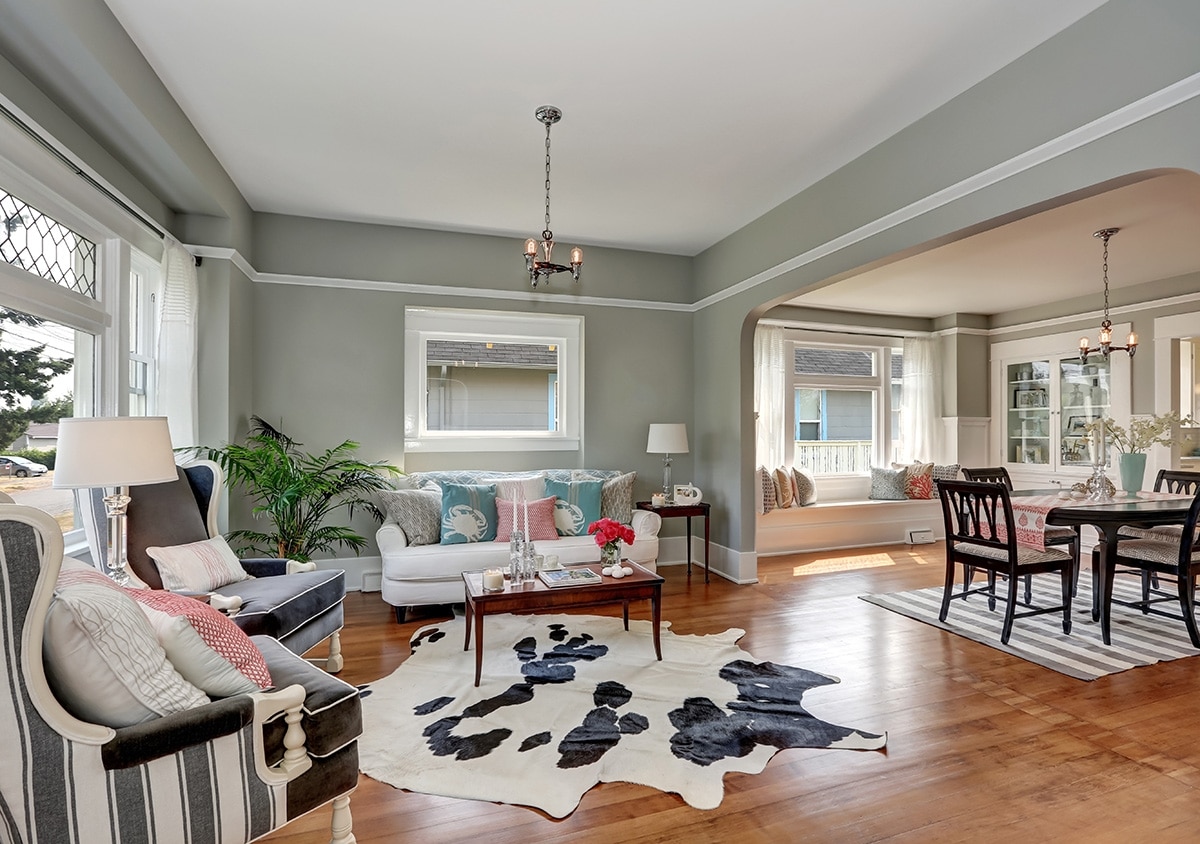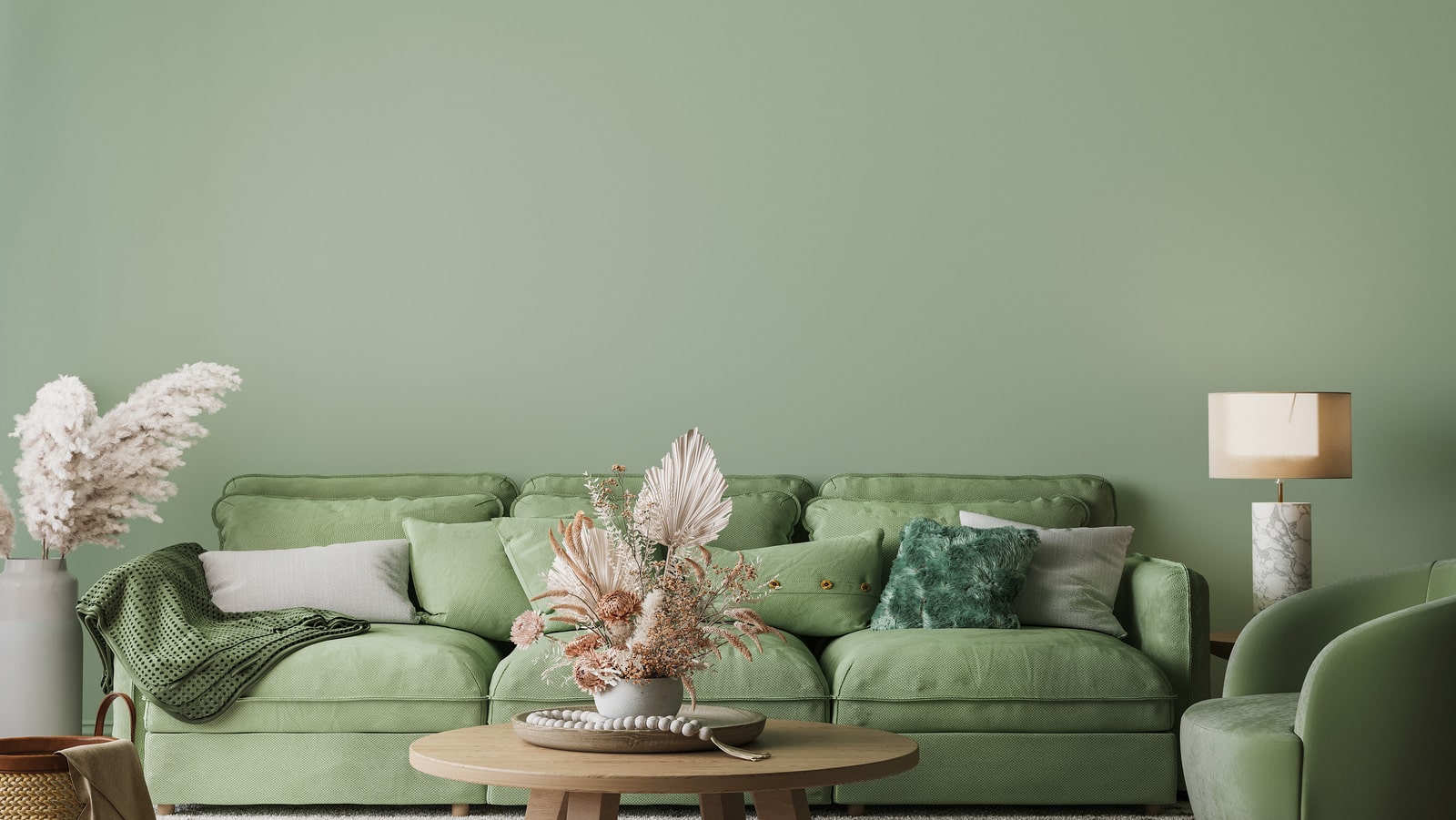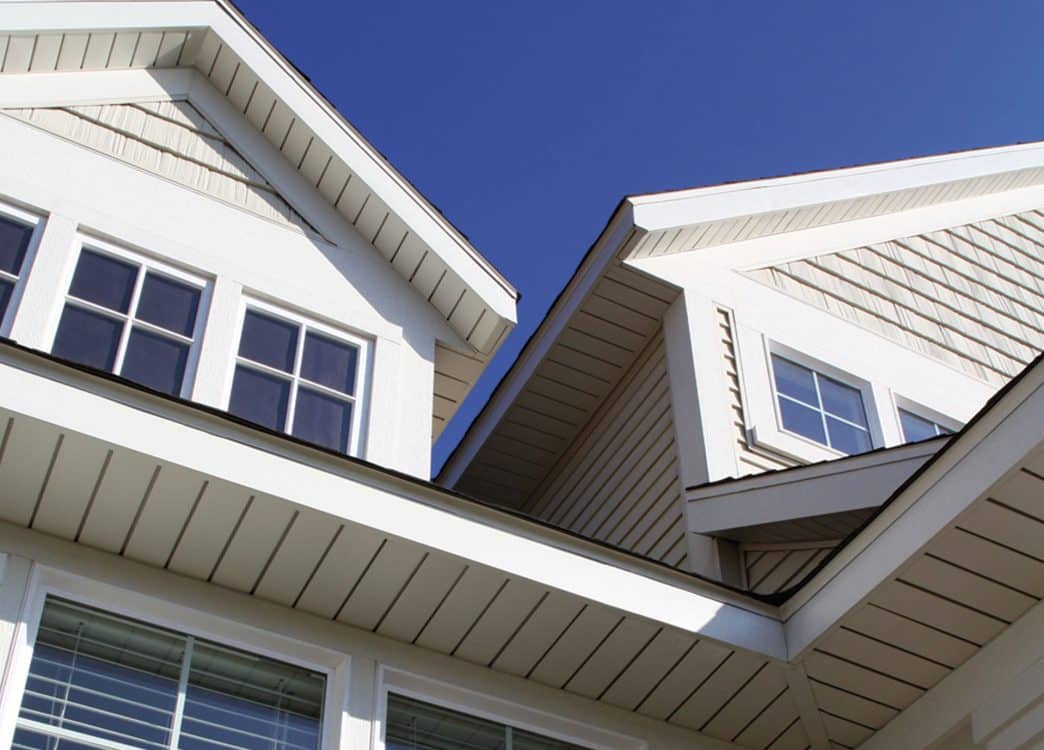Choosing the Right Size Rug for Your Entryway
When you open your front door, what’s the first thing guests see? Your entryway rug plays a big role in that initial impression.
It’s not just about looks – the right rug can warm your space and keep your floors clean. But picking the perfect rug isn’t as simple as it might seem.
Size matters a lot when it comes to entryway rugs. If they are too small, they might look out of place.
Too big, and your space could feel cramped. This guide will walk you through everything you need to choose an entryway rug.
We’ll cover sizes for different spaces, how to measure your entryway, pick the right shape, the best materials, and tips for keeping your rug in place and clean. Let’s find the ideal carpet for your home’s entrance!
What Is an Entryway Rug?
An entryway rug is a functional and decorative floor covering specifically designed for the area inside your home’s main entrance.
It is both a practical and stylish introduction to your living space. Here’s what you need to know about entryway rugs:
- Purpose: The primary function of an entryway rug is to trap dirt, moisture, and debris from shoes before they can be tracked further into your home. It is a transition zone between the outside world and your interior spaces.
- First Impression: As the first decor item guests encounter, an entryway rug sets the tone for your home’s style and ambiance. It’s an opportunity to create a strong visual statement and a welcoming atmosphere.
- Safety: Entryway rugs provide a non-slip surface for people entering your home, which is especially important during wet weather conditions. They help prevent slips and falls on smooth flooring materials like tile or hardwood.
- Floor Protection: By capturing dirt and moisture, these rugs protect your main flooring from excessive wear, scratches, and stains, potentially extending the life of your floors.
- Comfort: A well-chosen entryway rug offers a soft, comfortable surface to enter or leave your home, providing a pleasant tactile experience.
- Noise Reduction: Rugs can help absorb sound in entryways with hard flooring, reducing noise from foot traffic and contributing to a more peaceful home environment.
- Versatility: Entryway rugs come in various sizes, shapes, materials, and designs to suit different spaces and personal styles. They can be easily changed to update your entryway’s look or to match seasonal decor.
When selecting an entryway rug, consider factors such as size, material, durability, and ease of cleaning, as this area typically experiences high foot traffic and exposure to outdoor elements.
The right entryway rug can effectively combine functionality with style, creating an inviting entrance to your home.
What Are the Best Rug Sizes for Different Entryways?
Choosing the right rug size for your entryway is crucial for functionality and looks. The best size depends on the dimensions and layout of your space.
Here’s a guide to help you select the appropriate rug size for different types of entryways:
1. Small Entryways and Foyers
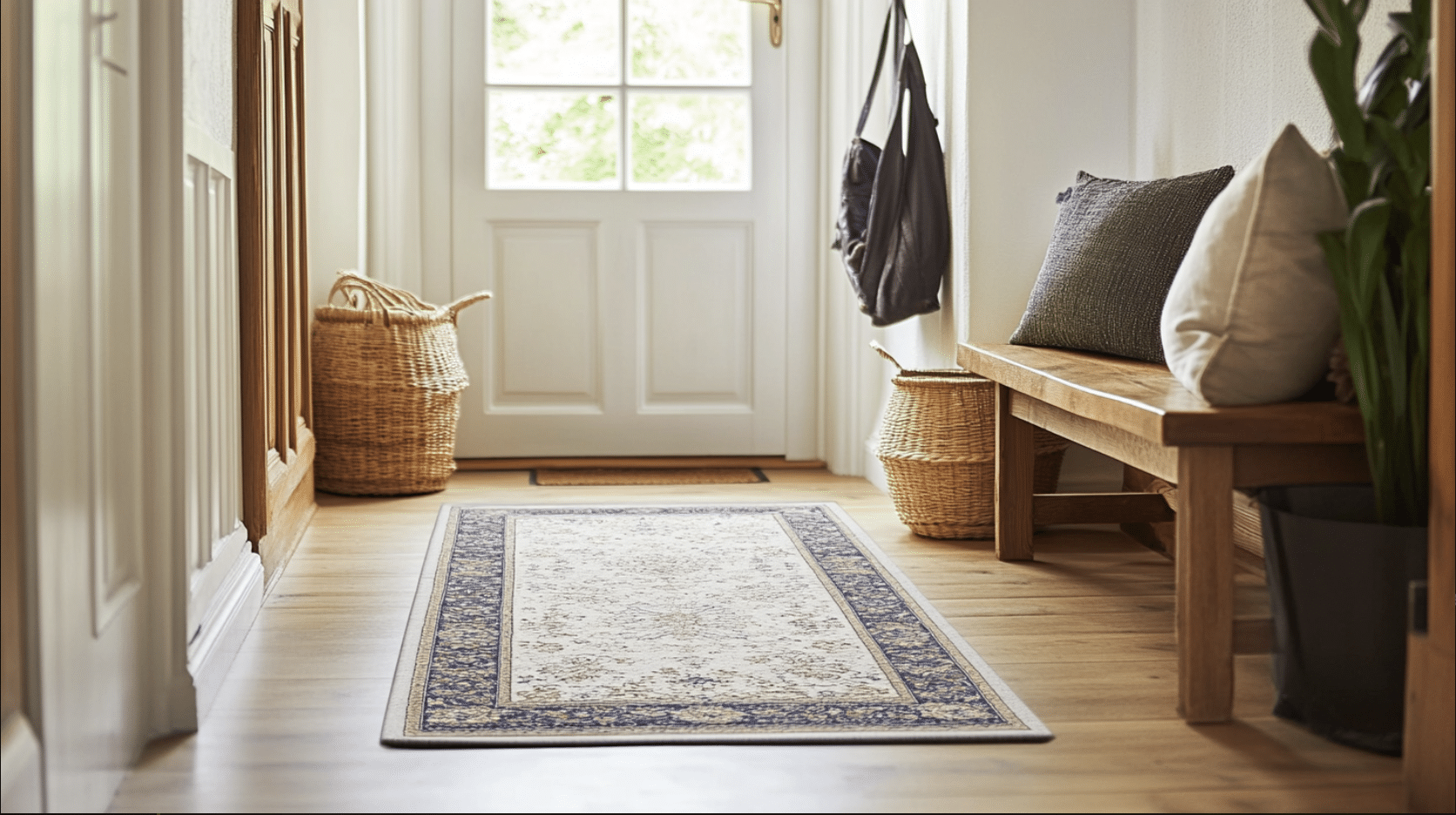
- Ideal rug sizes: 2’x3′, 3’x5′, or 2’x6′ runner
- These compact sizes provide enough coverage without overwhelming the space
- Aim to leave at least 6-12 inches of visible flooring around the edges of the rug
2. Large Entryways
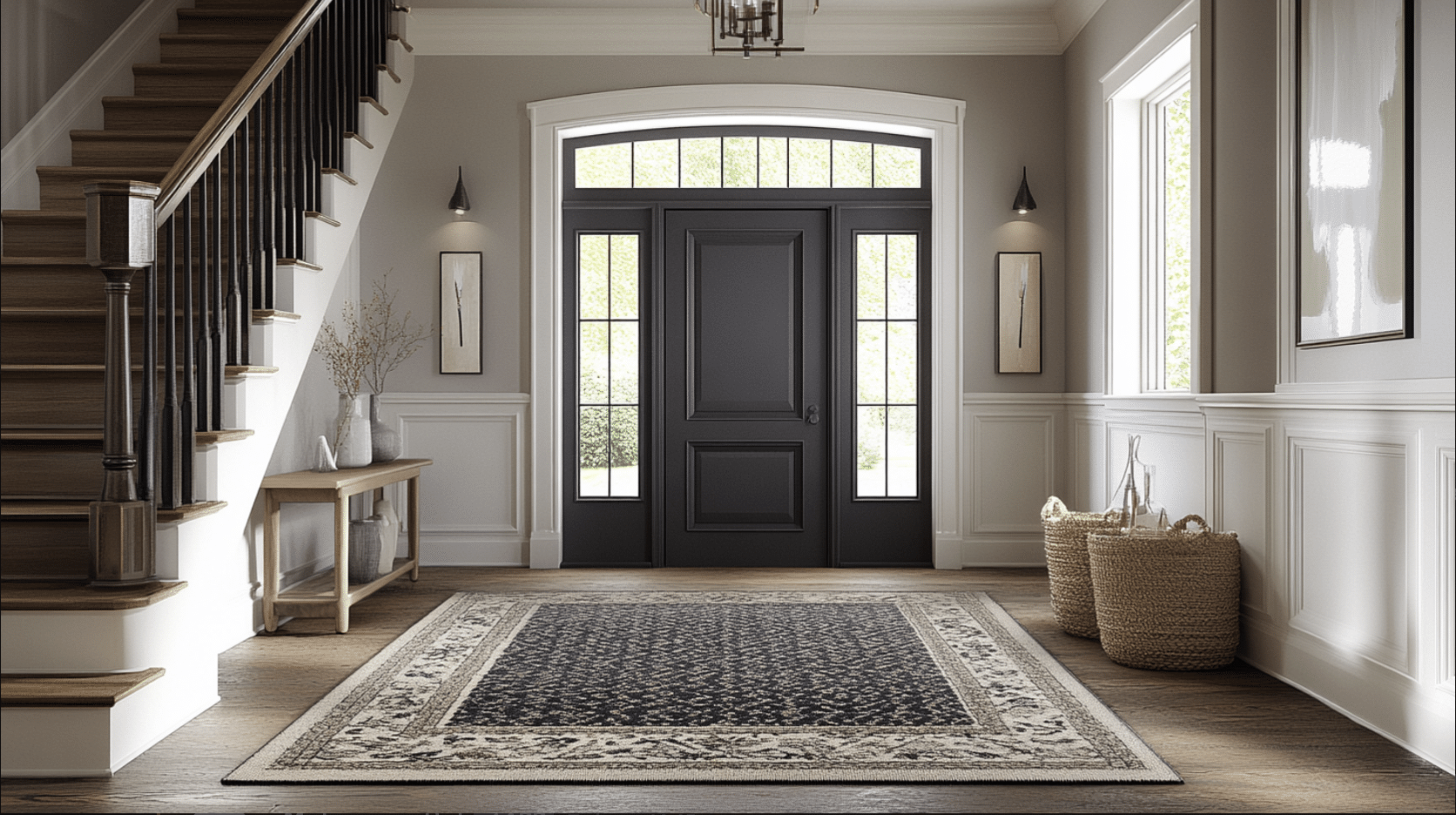
- Ideal rug sizes: 4’x6′, 5’x8′, 6’x9′, or 8’x10′
- These larger rugs can make a bold design statement in spacious foyers
- Ensure the rug doesn’t obstruct door openings or interfere with furniture placement
3. Long, Narrow Hallways
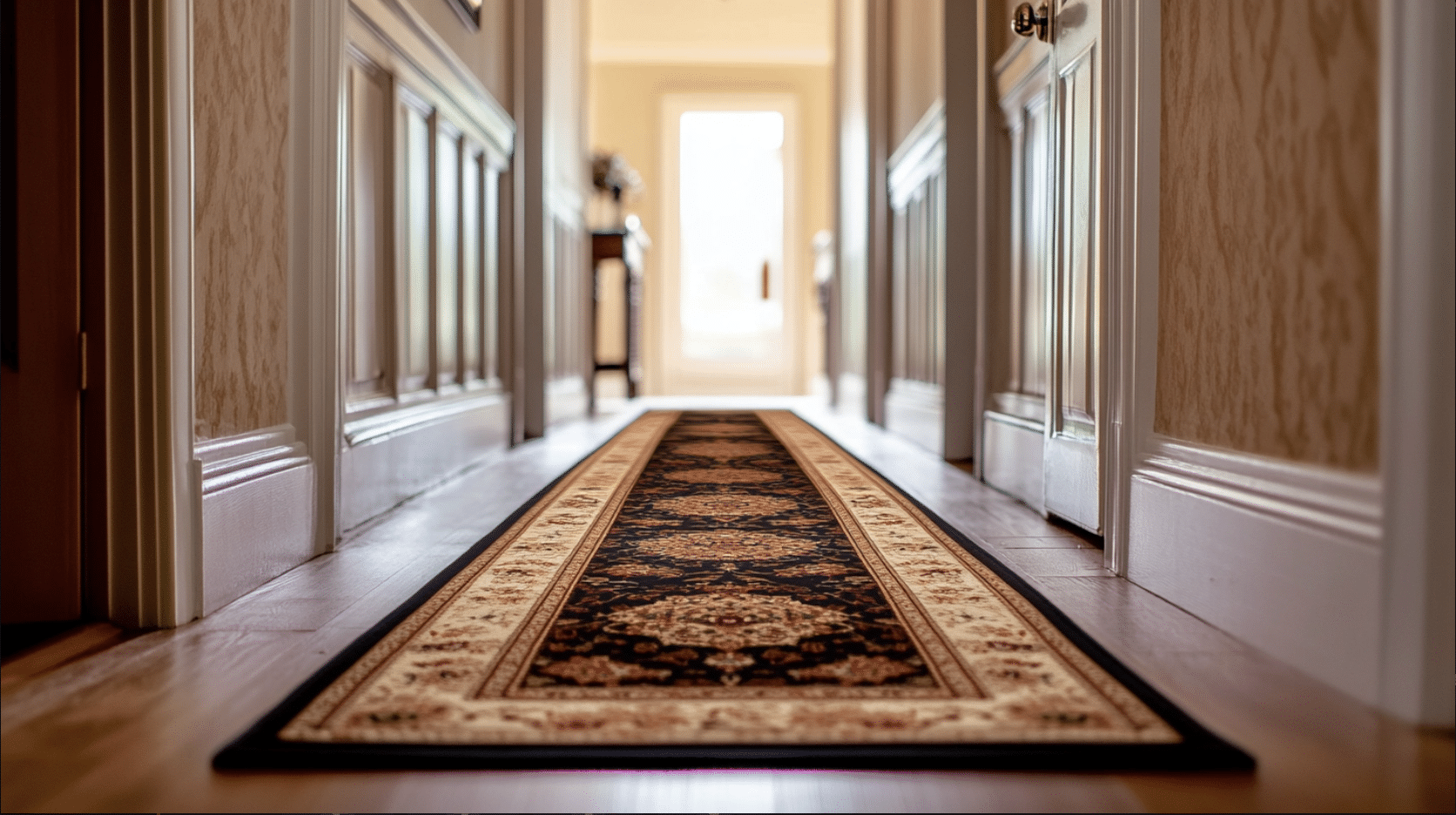
- Ideal rug sizes: 2’x8′, 2’x10′, or 3’x10′ runners
- Choose a length that leaves equal space at both ends of the hallway
- The width should allow for at least 4-6 inches of visible flooring on either side
4. Double Door or Wide Entryways
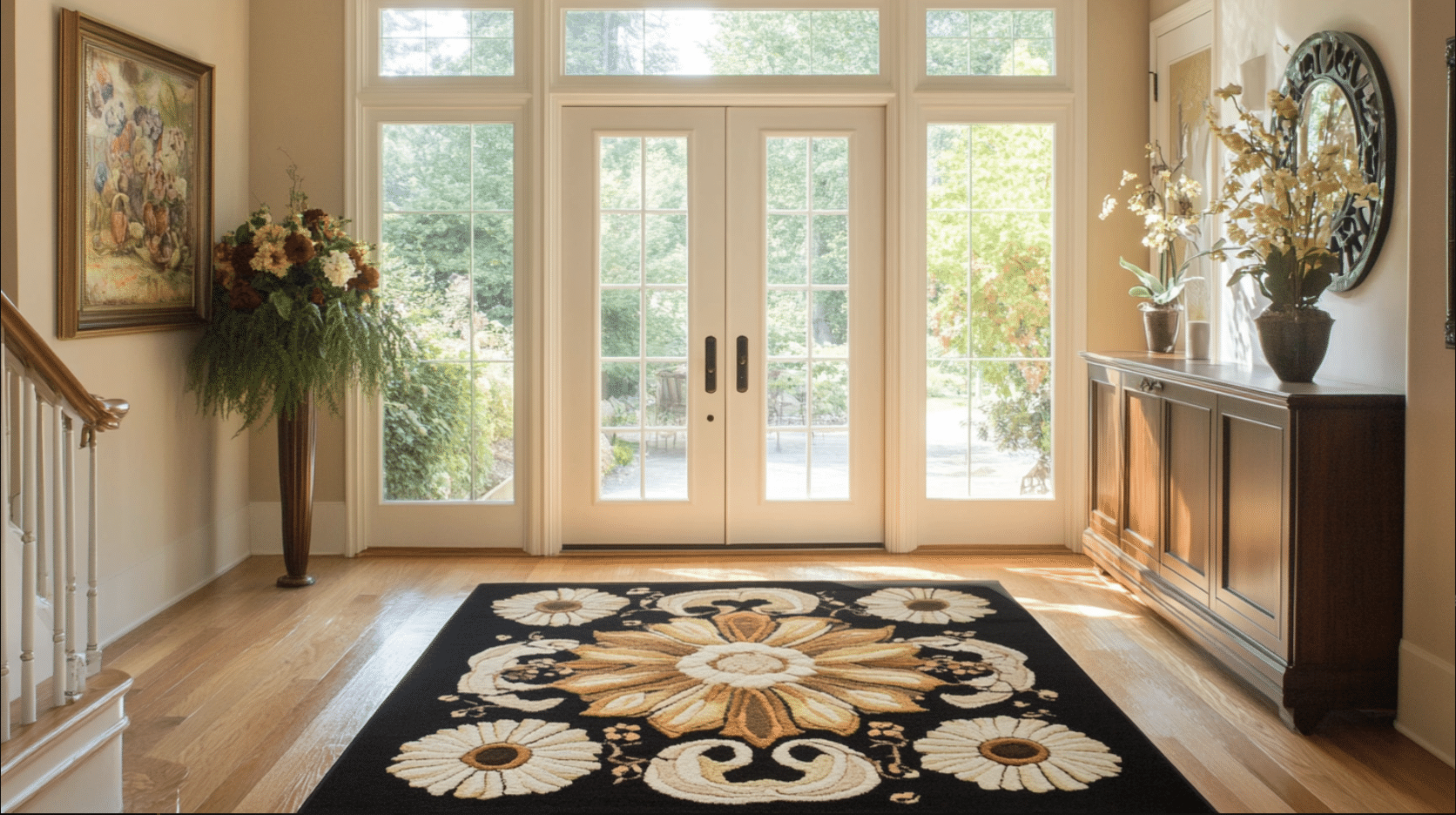
- Ideal rug sizes: 5’x8′ or 6’x9′ rectangular rugs
- For square-shaped entryways, consider a 6’x6′ or 8’x8′ square rug
- These sizes accommodate the broader space and create a balanced look
5. Circular Foyers
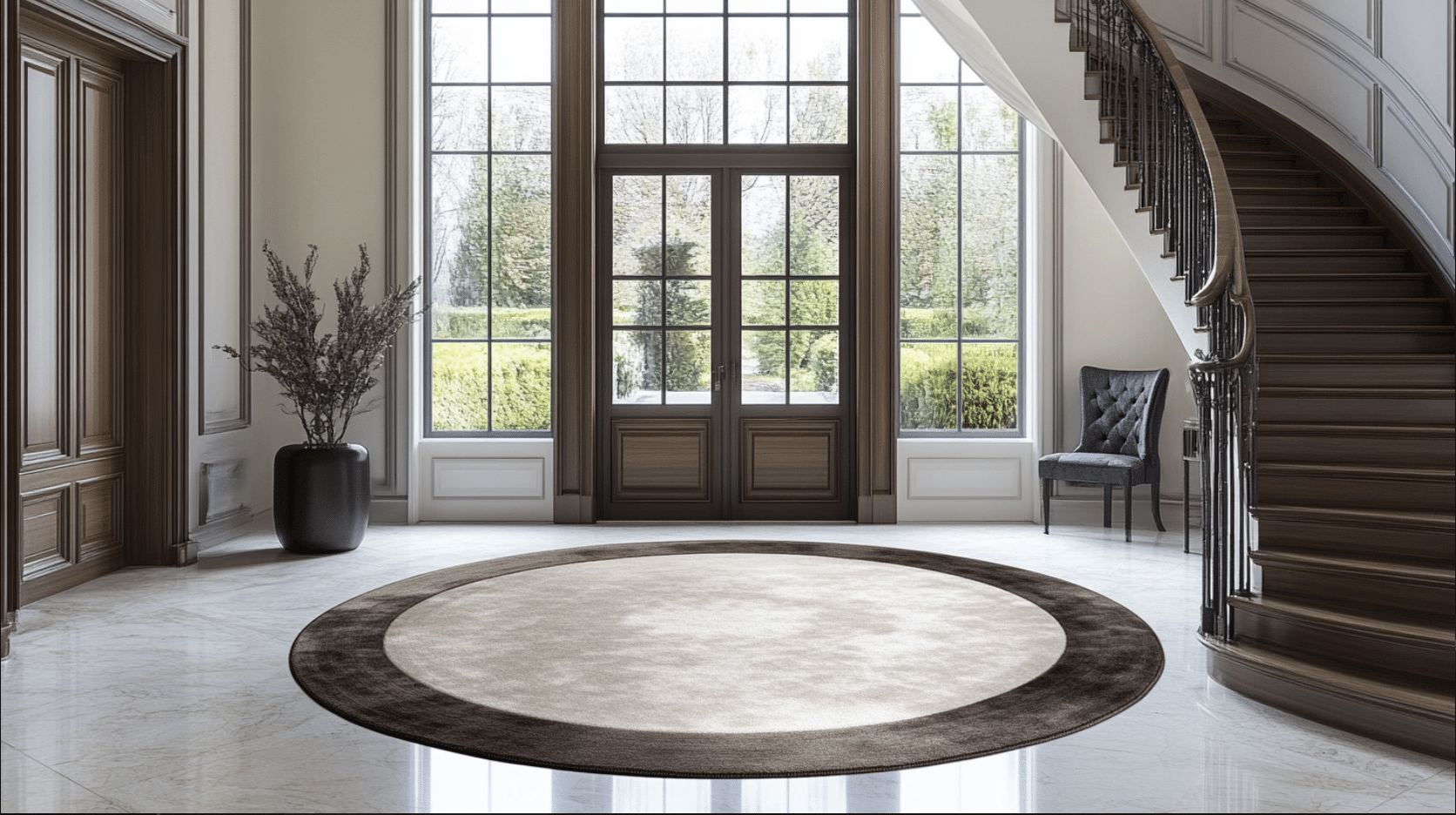
- Ideal rug sizes: 6′ or 8′ diameter round rugs
- Round rugs complement the shape of circular entryways or those with curved staircases
- Ensure the rug is centered in the space for a symmetrical appearance
Remember, these are general guidelines. The best size for your entryway will ultimately depend on its specific dimensions and layout.
Always measure your space before purchasing a rug, and consider using painter’s tape to outline potential rug sizes on your floor. This will help you visualize how different sizes will fit and look in your entryway.
Sizing Up Your Space: Selecting Entryway Rug Shapes and Sizes
1. Choosing the Right Shape

The shape of your entryway often dictates the most suitable rug shape. Different shapes can enhance various types of entryways:
- Long and Narrow Entryways: Runner rugs are the ideal choice for these spaces—Center the runner in the hallway, leaving at least 6 inches of space on either side. Standard runner sizes include 2’x8′ or 3’x10′, but the length can vary depending on your hallway’s dimensions.
- Wide or Open Foyers: Rectangular or square rugs can effectively define these spaces. A 6’x9′ or 8’x10′ rug can add warmth and create an inviting atmosphere in a spacious foyer.
- Circular Elements: If your entryway features circular elements, such as a grand staircase, consider a round rug to soften the angles and create a more harmonious flow.
2. Matching Shape to Architecture

When choosing a rug shape, consider matching it to architectural features:
- Rectangular Rugs: Work best for long, narrow spaces or standard foyers. They provide a classic look and are versatile enough to fit most entryway designs.
- Round Rugs: Great for square or circular spaces, especially under a statement chandelier or in foyers with arched doorways.
- Oval Rugs: This can be a good compromise, offering the elongated shape of a rectangle with the softer edges of a circle.
3. Sizing Considerations
Proper sizing is crucial for both looks and functionality:
- General Rule: Leave at least 6 to 18 inches of visible flooring around the rug’s edges. This provides a polished, framed look while ensuring the carpet doesn’t overpower the room.
- Small Entryways: A 3’x5′ rug or a 2’x6′ runner might be sufficient in compact spaces.
- Large Foyers: Larger spaces can accommodate rugs up to 8’x10′ or larger, depending on the room’s dimensions.
- Door Clearance: Ensure the rug size allows for proper door clearance. The rug should not interfere with the door’s ability to open and close freely.
Remember, the right combination of shape and size can dramatically enhance your entryway’s appearance and functionality.
Before making your final decision, take the time to consider different options and visualize how they would fit in your space.
Entryway Rug Fabrics: Making the Right Material Choice
Natural Fiber Options

- Wool: Wool is a premium choice for entryway rugs. It’s naturally durable, stain-resistant, and comfortable underfoot. Wool rugs can withstand heavy foot traffic and maintain their appearance over time. They’re also naturally soil-resistant and easy to clean. However, wool rugs tend to be more expensive than other options.
- Jute and Sisal: These natural fibers are popular for their durability and eco-friendly qualities. Jute and sisal rugs have a textured appearance that can add visual interest to your entryway. They’re great at trapping dirt and moisture, making them practical choices. Remember that these materials can be rough underfoot and may absorb spills quickly, requiring prompt cleaning.
- Cotton: Cotton rugs are soft, affordable, and often machine-washable, making them a practical choice for some entryways. However, they may not be as durable as other materials and can show wear more quickly in high-traffic areas.
Synthetic Fiber Options

- Nylon: Nylon rugs are known for their durability and stain resistance. They can withstand heavy foot traffic and are easy to clean, making them ideal for busy entryways. Nylon rugs are also available in a wide range of colors and patterns.
- Polypropylene: This synthetic material is often used for indoor/outdoor rugs, making it a great entryway choice. Polypropylene rugs are highly resistant to stains, moisture, and fading. They’re easy to clean and maintain, though they may lack the plush feel of natural fibers.
- Polyester: Polyester rugs are affordable and come in vibrant colors. They resist water-based stains well but may struggle with oil-based stains. While not as durable as nylon, polyester rugs can still be a good choice for moderate-traffic entryways.
Factors to Consider When Choosing Material
- Traffic Level: Consider how much foot traffic your entryway receives. High-traffic areas require more durable materials like wool or nylon.
- Climate: If you live in a rainy or snowy area, choose a material that can handle moisture well, such as polypropylene or wool.
- Budget: Natural fibers like wool tend to be more expensive, while synthetic options are often more budget-friendly.
- Visually pleasing: Consider the look and feel you want to achieve in your entryway. Each material has its unique texture and appearance.
By carefully considering these factors and material options, you can select an entryway rug that not only looks great but also withstands the daily wear and tear of your home’s entrance.
No-Slip Strategies: Keeping Entryway Rugs Firmly in Place
1. Use of Rug Pads
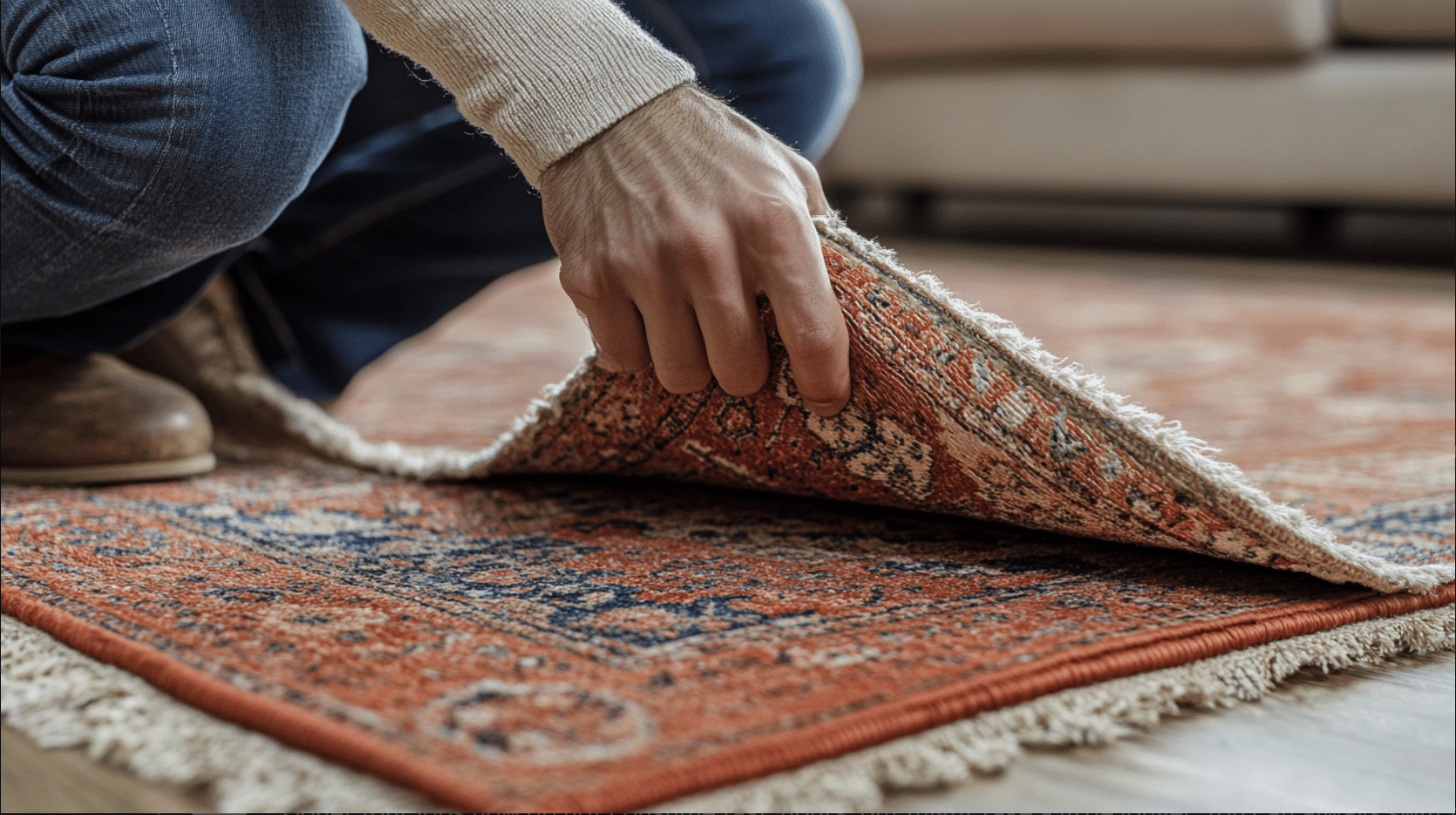
Rug pads are the most effective method for securing entryway rugs. They provide grip between the rug and floor, preventing slips and slides.
Choose a pad slightly smaller than your rug to keep it hidden. Pads also add cushioning and protect both the rug and floor from wear.
2. Additional Securing Methods
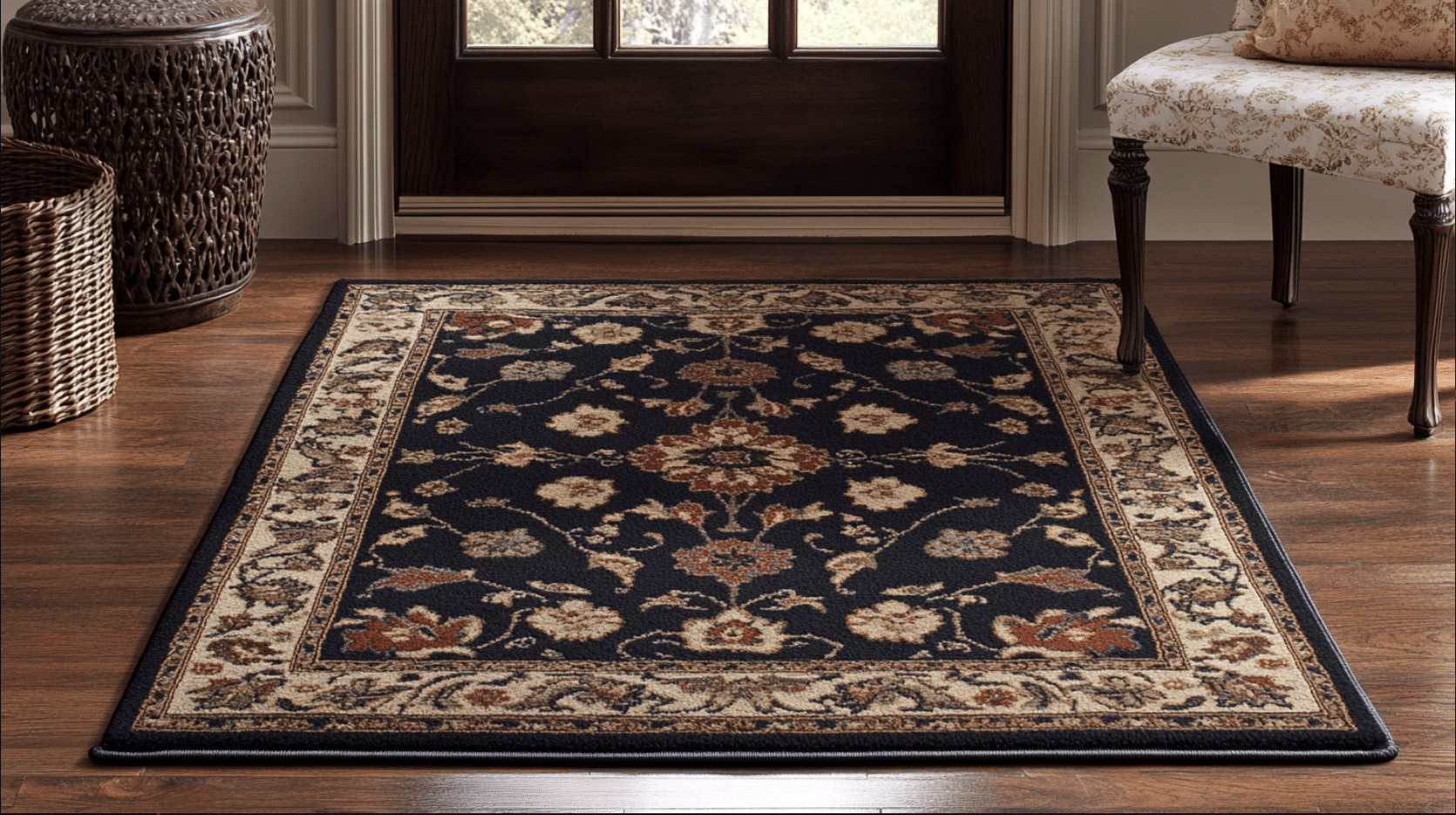
Consider rug grippers or double-sided rug tape for extra stability, especially on smooth surfaces.
These adhere to both the rug and floor, offering powerful slip prevention. For best results, use them strategically at corners and edges.
3. Rug Selection and Placement
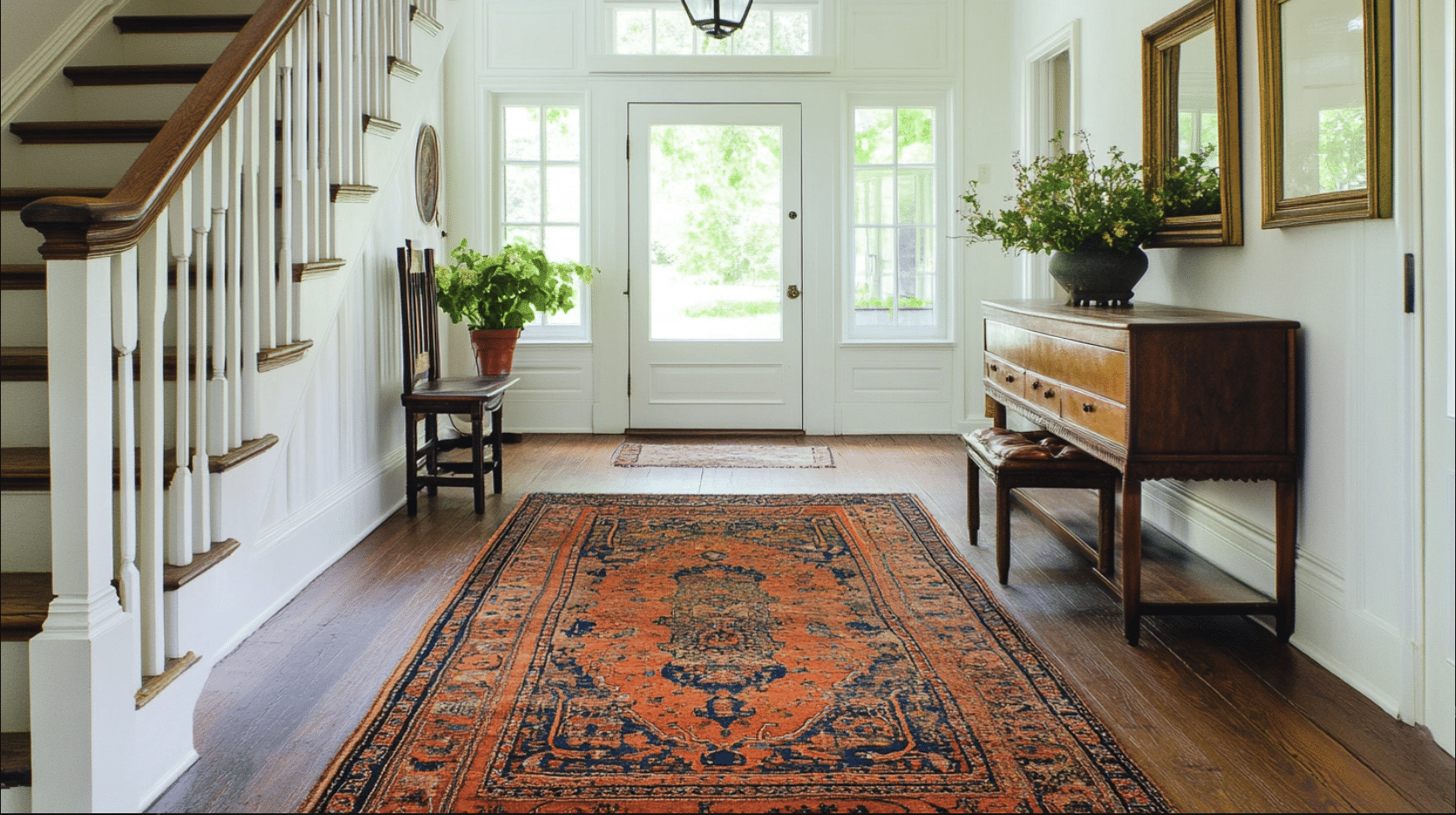
Opt for low-pile, heavier rugs in high-traffic entryways, which are naturally more stable.
Strategic furniture placement, like a console table or bench partially on the rug, can add weight and stability. However, this should not create tripping hazards.
Entryway Rug Maintenance: Cleanliness and Longevity Tips

1. Regular Vacuuming
Vacuum your entryway rug at least twice weekly or more in high-traffic areas. Use a vacuum with adjustable height settings for different pile heights.
For thin rugs, use a suction-only attachment. Pay extra attention to edges and corners where dirt accumulates.
2. Immediate Stain Treatment
Act quickly on spills to prevent permanent stains—Blot (don’t rub) with a clean, white cloth. For water-soluble stains, use a mixture of water and mild detergent.
Oil-based stains may require a dry-cleaning solvent. Always test cleaning solutions on an inconspicuous area first.
3. Periodic Deep Cleaning
Clean your rug every 12-18 months or more often in high-traffic areas. Consider professional cleaning, or use appropriate rug shampoo if you do it yourself.
Ensure the rug is completely dry before replacing it to prevent mold growth.
4. Rotation and Sun Protection
Rotate your rug every few months for even wear. Use window treatments to minimize direct sunlight exposure, which can cause fading.
For sunny entryways, consider UV-resistant materials or be prepared for more frequent replacements.
Conclusion
Choosing the right entryway rug involves careful consideration of size, shape, material, and maintenance.
By selecting the appropriate rug, securing it properly, and maintaining it regularly, you can create a welcoming, safe, and stylish entrance to your home.
Remember to measure your entryway, consider the traffic levels, and choose a material that suits your lifestyle and climate.
We encourage you to take action today. Measure your entryway, visualize different rug options, and select the perfect rug to complement your space and meet your needs.
Your entryway is the first impression of your home – make it count! Transform your entryway and upgrade your home’s welcome with the perfect rug!
Frequently Asked Questions (FAQs)
What Size Rug Is Best for A Small Entryway?
For small entryways, a 2’x3′ or 3’x5′ rug works well. Runners (2’x6′ or 2’x8′) are also good options, depending on the space’s shape and available area.
What Materials Are Best for Withstanding Heavy Foot Traffic?
Wool, nylon, and polypropylene are excellent materials for high-traffic entryways. They are durable and stain-resistant and maintain their appearance well under frequent use. Sisal and jute are also good options.
How Much Space Should Be Between the Rug and The Door?
Leave about 6-8 inches between the rug and the door. This ensures the door can open freely and provides a transition space for wiping feet before stepping onto the carpet.



